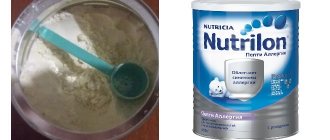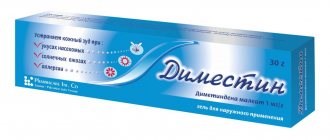After the birth of a long-awaited baby, every woman thinks about how she will feed the child. Pediatricians believe that the best food for infants is mother's milk. After all, it saturates the child with those microelements and nutrients that are so necessary for a growing organism, helps him adapt to his new environment. The elements contained in breast milk ensure the growth of all organs and tissues of the body.
But there are times when a mother cannot breastfeed her child. One of the primary reasons is the lack of lactation, the presence of serious serious illnesses in the mother, and the use of medications that can harm the baby. And then the issue of artificial feeding of the baby is decided. Today there is a very large selection of artificial breast milk substitutes. It is the mother who faces the question of which formula to choose, and how to determine whether the formula is suitable for the newborn or not. After all, she is nearby 24 hours a day, watching and caring for him. Due to the disappointing consequences of the formula’s reactions on the child’s body, it is necessary to select dairy products for a newborn for a long time. There are certain signs based on which we can make a conclusion about the baby’s condition after each meal.
Monitor the baby's condition
Artificial products can be divided into age-specific mixtures corresponding to the baby’s age:
- An infant up to six months old needs to buy nutritional formulas that contain a concentrated complex of essential proteins, fats, minerals and vitamins, as well as amino acids. Moreover, the calorie content of the product should be at least 65-73 units. At the same time, the composition should not contain excess liquid, since at this time the formation of the renal system occurs in children. It is also desirable that the proteins contained are whey, which are more easily and quickly absorbed by the child’s body.
- From six months to one year, the “second formula”, enriched with carbohydrates and proteins, is relevant for children - this is due to the growth of the baby and an increase in its activity, and these components allow you to build the baby’s muscles and provide him with energy.
- Children who are 12 months old need an updated composition, in which the emphasis should be on macro, microelements, vitamins and compounds necessary for the development of a healthy intestinal environment. This is important for the development of his immune system.
When the formula is not suitable for a newborn, this may be due to the presence of childhood diseases, including indigestion, deficiency of certain enzymes or their low level in the body, and metabolic pathologies.
The pediatrician should select the most optimal formula for the newborn. But then it is the mother who closely monitors the condition of the baby and his nutrition. The mixture is not suitable for the baby and requires replacement in the following cases:
- Rash on the skin
- Colic, gas
- No weight gain
- Problems with the gastrointestinal tract
- Profuse regurgitation
- Taste rejection
All of the above indicators indicate that this milk formula is not suitable for a newborn, and therefore it should be replaced with another.
Below we will discuss these features in more detail, since it will be problematic for a young mother to understand that the formula is not suitable for a newborn without knowing the symptoms.
How to identify signs of an unsuitable formula for a baby: understand by symptoms
Problems with artificial and mixed feeding are often associated with infants' intolerance to cow's protein.
To choose tactics for eliminating the problem, it is necessary to determine what was the real cause of the baby’s well-being: an allergy to milk protein or its intolerance.
There are a number of rules, the purpose of which is to resolve the issue of how to understand that the mixture is not suitable for a baby.
Baby with a bottle
Possible problems with mixed feeding
Mixed feeding involves supplementing the baby after breast milk with formula or milk from farm animals such as a cow or goat. Problems that arise during supplemental feeding may vary, depending on what exactly is given to the child.
When using cattle milk, the most common gastrointestinal disorders of an infant are:
- constipation;
- regurgitation, from which the child suffocates;
- bloating due to severe gas formation;
- intestinal cramps;
- dermatitis.
Constipation can be caused by feeding cow's milk. This is explained by the fact that when it curdles in the stomach, it forms one large lump. After passing through the duodenum, then the small and large intestines, milk turns into dense lumps of feces, which, in addition to pain, create difficulty in defecation.
Goat milk curdles, unlike cow milk, into smaller grains, which reduces the risk of constipation. But regurgitation of such a product causes a lot of inconvenience to the child.
Mother's milk and adapted milk formula remain liquid even after souring, which makes regurgitation safe. The passage of curd lumps formed from goat's milk through the respiratory tract can be dangerous.
Getting stuck in the nasal passages or on the walls of the throat, they significantly complicate the baby’s breathing.
Curdling cow's milk
Infant formula, adapted for any age of the child, is prepared on the basis of cow's milk. Thanks to special processing, it does not turn into one big lump under the influence of gastric juice. Therefore, formula milk does not cause problems of constipation when dosed correctly.
Important! The presence of cow protein in infant formula causes abdominal discomfort and dermatitis in children with cow protein intolerance.
Detection of mixture intolerance
Lactose-free formula for newborns
Before rushing to replace the mixture, you need to make sure that it really is not suitable.
Formula intolerance usually involves the body's inability to break down cow's protein.
If your baby develops any skin reactions or digestive problems, it is important to make sure that the mother prepares the portion correctly:
- The ratio of water and dry matter must strictly correspond to the proportions indicated on the packaging. Many mothers, thinking that by adding more scoops to the bottle, they will make the formula healthier and more nutritious, are greatly mistaken. Violation of proportions during cooking almost always causes dermatitis and problems in the gastrointestinal tract. Excess protein and fat in an improperly prepared portion puts excess stress on the liver and kidneys.
- The amount of mixture drunk should not exceed the volume stated on the package for each age group. Overeating causes increased gas formation in the intestines and abdominal pain.
- Preparing the mixture for future use, especially storing it in a water bath at night, leads to intestinal infections. You can only feed your child a freshly prepared portion, because it is a breeding ground for the proliferation of pathogenic bacteria. For the same reason, it is necessary to thoroughly wash the bottle, nipple and all its folds after each use, using a stiff brush or brush.
If each portion is always prepared by the mother according to the rules, and the child does not overeat, but at the same time there are obvious problems with digestion, it is worth thinking about how to understand that this particular mixture is not suitable for the child.
Preparing the mixture
What are the symptoms?
Unpleasant symptoms associated with a reaction to milk protein can occur for two reasons:
- allergy to cow's milk protein;
- Milk protein intolerance.
If the symptoms are associated specifically with an allergic reaction, then the child will have to give up dairy products for life. Intolerance most often goes away with age. By the age of three, most of the negative reactions that arise from drinking milk disappear, due to the maturation of the intestines and an increase in the quantity and quality of bile enzymes.
Protein intolerance causes the following symptoms:
- severe abdominal pain;
- diarrhea;
- vomit.
If the baby has an allergy, symptoms characteristic of intolerance may appear; the main distinguishing criterion is skin reactions. It is dermatitis that becomes the reason to visit an allergist.
When do the signs appear?
An allergic reaction appears within 15 minutes after taking the mixture and can linger for a long time. With age-related milk protein intolerance, the first symptoms will appear immediately after the first drops of what is eaten enter the duodenum, since it is the duodenum that first reacts with the inability of the existing enzymes to break down the product.
It will take 3-4 weeks to diagnose an allergic reaction. To achieve a reliable result you must:
- exclude milk protein from food for a long time;
- observe the disappearance of dermatitis and disturbances in the gastrointestinal tract within 3-4 weeks;
- as soon as the symptoms have completely disappeared, give a single portion containing the suspected allergen - milk;
- When previously disappeared health problems reappear, a diagnosis of “cow protein allergy” is made.
Important! Children who are not only bottle-fed, but also breast-fed, may show signs of allergies. If a nursing mother eats cottage cheese, cheese or any other dairy product, the protein will enter her milk, and then into the newborn’s gastrointestinal tract.
Safe alternative to inappropriate formula
Baby formula for newborns - how to prepare
The popular doctor Evgeniy Komarovsky in his lectures says that if there are negative reactions to cow's milk protein, almost always (in 90% of cases) the problem will recur when consuming goat's milk.
Soy mixtures can cause similar symptoms in 50% of cases. This is due to the fact that cow's milk protein is very similar in structure to goat and soy protein.
It is resistant to high temperatures, so boiling will not reduce the severity of reactions from the gastrointestinal tract and skin.
Digested protein
The only way out will be a mixture in which the protein is present in a split form. There are manufacturers who, while still in production, use special enzymes to convert protein into hydrolysate. This mixture will be a salvation for infants with allergies. Parents will only have to choose their preferred brand.
Important! It is wiser to opt not for a rare and fashionable manufacturer, but for a brand that can be easily purchased at any time in any children's store.
Signs of good digestibility of the mixture
In order to find out whether the formula is suitable for a baby or not, you need to monitor the child’s condition not only after consuming the next portion, but also over a long period of time, over time.
Which formula to choose for a newborn with mixed feeding
Parents should understand that intestinal colic does not depend in any way on whether the child is breastfed or bottle-fed. In a large percentage of children, the first colic appears at the age of 3 weeks and goes away on its own by 3 months. It is not difficult to distinguish them from mixture intolerance. Signs of colic are:
- a shrill cry, different from the way a child asks to be held or reports hunger;
- lack of direct connection with food intake;
- the appearance of abdominal pain at approximately the same time;
- the duration of the scream can last up to 1.5-2 hours;
- inability to calm the baby with a bottle of formula or the mother's breast.
Intestinal colic is an age-related feature of intestinal development. If, apart from pain, the baby does not suffer from anything (no vomiting or diarrhea), then the mixture is not to blame, you need to be patient and live until 3 months of age.
You can be sure that the formula is suitable for the child if the following facts are noted:
- after the vast majority of feedings the baby is in a good mood;
- no rashes on the skin;
- no frequent, repeated regurgitation;
- the child gains weight according to the norms prescribed for his age.
Interesting! It is the weight gain and increase in body length that indicate that the baby is eating a product that is well absorbed by the body. In this case, there is no need to select any new mixture; the search can be stopped.
Situations requiring medical consultation
If a breastfed or mixed-fed child has been diagnosed with an allergy to milk protein, it is necessary not only to look for hypoallergenic formulas based on split protein, but also to adjust the diet of the nursing mother. Her diet should not contain dairy products in any form.
In this case, a doctor will be needed in order to correctly select a set of preparations containing calcium for the woman, since her body will not naturally receive an important microelement due to diet.
Additionally, you should not ignore the use of calcium. The period of breastfeeding is famous for the fact that the female body is depleted due to improper and inadequate nutrition.
To keep your teeth healthy and your bones intact, taking calcium after consulting a doctor is necessary.
When a baby, especially a newborn, exhibits any skin reactions, you should contact a specialist. This may not always be a reaction to nutrition. There are a considerable number of serious diagnoses, the clinical picture of which begins with redness of the skin. Therefore, for any changes in the child’s body, you should consult a doctor.
Food dermatitis
Medical statistics claim that only 2% of the world's population is allergic to milk protein. Moreover, almost half of children suffer from intolerance to formula milk before the age of one year.
This suggests that milk is very rarely to blame for the baby’s poor health.
Most often, the cause of negative symptoms is the mother who overfeeds the child and prepares the formula with incorrect proportions.
Source: https://kpoxa.info/sovety-mamam/ponyat-smes-ne-podxodit-grudnichku.html
Types of products
Every mother who finds herself in this situation naturally has a question: how to choose a formula for a newborn? There are many types of milk formulas on the Russian market. First you need to figure out how they differ. The main difference between all types of mixtures is the age of the child. Infant formula for newborns has a certain composition, but for older children it is different.
This is not surprising, because the body’s need for microelements and various vitamins changes as the baby grows. Mixtures vary in consistency. Liquid mixtures are more convenient, because they are ready for use and only require heating. But the choice of liquid mixtures is still a privilege of large cities, since they have a short shelf life and require certain transportation conditions.
Dry mixtures are presented in almost every supermarket and children's food store in a wide variety. They are easy to store and prepare. Powdered milk mixtures differ in composition. Most formulas for newborns are based on cow's milk, but they are also made from goat's milk, as well as from soy, with the addition of bifidobacteria and probiotics.
What should mom pay attention to?
Let us conditionally divide all formulas for babies into the following types:
- Dry mixtures intended for dilution with boiled water;
- Medicinal mixtures;
- Liquid mixtures (ready-to-use);
- Unleavened formulas (optimal for the first six months of a baby’s life);
- Fermented milk mixtures (can be introduced from 6 months of the baby’s life).
The vast majority of infant formula is made from cow's milk. In order for cow protein to be successfully absorbed by the child’s gastrointestinal tract, it undergoes special treatment. It ceases to be allergic and becomes similar to the protein of mother's milk.
Food allergies
After eating, the baby's skin became covered with a rash, cough and runny nose. The rash can be observed on the face, head, and other parts of the body. In some severe cases, hives may occur. This is how an allergic reaction to the mixture manifests itself. Therefore, when swaddling a baby, you should carefully examine his skin.
In any case, if allergic reactions occur, this is a sign that the newborn’s body did not like the proposed food novelty. Pediatricians advise observing the baby's reaction to a new type of formula for 72 hours. If the body adapts to the innovation, then the rash and itching of the skin go away.
Why are medicinal mixtures needed?
In different situations, the baby may need a mixture with a therapeutic effect. But only a doctor prescribes them. And this often happens when a child has a high degree of intolerance to cow's milk protein, then he needs soy-based formulas.

A fairly common pathology today is that the child’s body produces insufficient amounts of the enzyme to break down lactose. Such children should be given either low-lactose or completely lactose-free formulas. Accordingly, the inscription on the boxes with this family will be “NL” and “BL”.
If the baby's allergic reaction to the formula is quite serious, he will also need a special medicinal mixture. This time it will be a hypoallergenic mixture (“HA”); if the child’s absorption and digestion of the mixture is impaired, he will also be prescribed this medicinal mixture. This type of baby food is called semi-elementary.
And babies who spit up very often, and who may vomit after feeding, need anti-reflux mixtures (“AR”).
Price
The price category varies from 200 rubles or more, depending on the composition, manufacturer’s brand and packaging. In this case, price is not the answer to the question of what formula to feed a newborn - more expensive or cheaper? Both domestic and foreign manufacturers are distinguished by good quality. Inexpensive milk formulas, usually from a Russian manufacturer, are well absorbed by many children, while expensive formulas from a European manufacturer may contain GMOs and various vegetable oils.
Whether a child will accept formula milk or not can only be understood with an individual approach. When switching to artificial feeding, it is necessary to consult with a pediatrician about the baby’s nutrition and how to understand that the formula is not suitable for the child. If certain physical indicators are present, the doctor may recommend a specialized milk formula containing a particular microelement.
Composition of mixtures: what to pay attention to?
To understand what exactly the baby is, you should look at the “ingredients” item on the box with the formula. Let's go through the main components of this list.

Fats. Of course, they are important, because they are responsible for the presence of very important fat-soluble vitamins and, of course, are responsible for the calorie content of the mixture.
Squirrels. It is very important which protein predominates in the mixture. The best option is the whey fraction.
Carbohydrates. A formula that contains only lactose is suitable for feeding a child. And this is understandable, because in breast milk the same lactose makes up about 90% of all carbohydrates. There are mixtures where, in addition to lactose, glucose polymers are added. But mixtures containing sucrose are not the best option.
Iron. You should not choose a mixture with a high content of this element, unless your doctor has prescribed it for a specific reason. Otherwise, regurgitation may occur, the baby’s stool may change, etc.
Intestinal colic
After eating, the children, having had enough, fall asleep. In the case when the mixture is not suitable, the baby experiences colic, pain in the stomach, as evidenced by a piercing squeal, the child kicks his legs, cries endlessly during meals, and also after it. This is especially evident at night, the baby sleeps poorly, spins, and is capricious.
Irritability is also characteristic of him during the daytime. These symptoms can also occur because the baby swallows too much air with the formula when sucking. Or he holds the pacifier in his mouth incorrectly. After each meal, it is necessary to hold the baby upright so that the accumulated gas comes out.
Child's reaction
So, we have decided how to choose a formula for a newborn. Now you need to see the baby’s reaction to the new food. You should not change the mixture at the first unsuccessful attempt. Adaptation to a new product takes about three days for a baby. For the first time, you should give your baby one measuring spoon of the prepared milk formula to try, on the second day - two spoons, and then increase by one serving.
When a new product is suddenly introduced into the diet, there may be a severe allergic reaction due to its large intake into the body. If the baby took the mixture and remained full, then it suited him. Although there is no guarantee that he will use it constantly. Over time, many mothers had to change formulas, more than once.
The easiest and fastest way to determine whether a new diet is suitable for a baby is by looking at the skin. It is on the skin that parents will most quickly notice changes. Most often, the cheeks turn red, this is the so-called diathesis. The rash can spread throughout the body, be accompanied by itching, peeling and even develop into ulcers.
If such problems arise, first of all, make sure that the child has not taken medications in the coming days, that there have been no other new foods in his diet, and that the fabrics and materials in contact with the baby’s skin are breathable and do not rub.
Important: when mixed feeding, it is necessary to take into account the diet of the nursing mother; if the woman has recently eaten any unusual food, this could also contribute to the appearance of the rash.
If no other cause besides the new baby formula has been identified, wait a couple of weeks. Perhaps the child’s body will get used to the new diet. If symptoms persist or worsen, contact your pediatrician. He will recommend a hypoallergenic mixture with a suitable composition.
anaskon
How to introduce a new formula into a child's diet? If for some reason it turns out to be necessary to introduce a new formula into the child’s diet, then this must be done gradually. Often, the mother herself decides to change the formula to “something better” and introduces it in full in one day. A few days later she learns about the existence of a “more modern” mixture and, again with the best intentions, quickly exchanges the old mixture for a new one. It’s good if the baby doesn’t react to this in any way, but sometimes the child may have an allergic reaction or some kind of digestive disorder. And not only because the food may not have been chosen correctly, but to a greater extent because of its illiterate introduction into the child’s diet. Any new mixture (regular or medicinal) must be given in very small quantities, increasing its volume due to the volume of gradually replaced food. Olga Lukoyanova Pediatrician, researcher at the Department of Nutrition for Healthy and Sick Children of the Scientific Center for Children's Health of the Russian Academy of Medical Sciences, Moscow, Ph.D.
TO A NEW MIXTURE (from one mixture to another):
Start giving any new infant formula in very small quantities, from a separate bottle, before feeding the usual formula. As the amount of the new mixture increases, the volume of the usual mixture is reduced.
Scheme No. 1
Note to the table:
Two different mixtures must be prepared in two different bottles. The first day you give 10 ml. in one feeding. First the new mixture, then supplement with the old mixture. This is because after a familiar formula and having already eaten, the child may refuse a new one. The rest of the feedings use the old formula.
On the second day, give 10 ml. at the beginning of three feedings. This can be three feedings in a row or through feedings, as is convenient for you. Just not the first and not the last feeding, they are replaced at the very last place. On the third day, 20-30 ml. at the beginning of three feedings. On the fourth day 50-60 ml. at the beginning of five feedings. Accordingly, prepare 50-60 ml of the old mixture in another bottle. less. On the fifth day 90-100 ml. at the beginning of four feedings, then feed the rest with the old mixture. And on the sixth or seventh day, completely switch to the full volume of the new formula at all feedings.
Scheme No. 2
Another option for introducing a new mixture:
So you introduce a new one within a week. Scheme No. 3 Term Number of ml* Frequency of administration per day Number of administrations per dose ml 1 day 5.0 1 5.0 2 day 10.0 1 10.0 3 day 10.0 3 30.0 4 day 20 .0 3 60.0 5 day 50.0 3 150.0 6 day 100.0 4 400.0 7 day 150.0 4 600.0 8 day 150.0-200.0 4-6 600.0 and further and more *Note: 1 teaspoon corresponds to 5 ml of finished product. On the NE, starting from the 3rd day and all subsequent days, the mixture lasts 2 times a day.
FOR MIXTURE No. 2 (SECOND STAGE):
Option 1
| Scheme of transition to the next mixture (PS) | ||||
| Day | Morning | Day | Evening | Before bedtime |
| 1st stage | PS | 1st stage | 1st stage | |
| 1st stage | PS | PS | 1st stage | |
| PS | PS | PS | 1st stage | |
| PS | PS | PS | PS | |
Important: when switching to PS, do not give it to the first and last feeding.
Scheme of transition to the next mixture (combination for each feeding)
Option 2
| 1st day | 3 parts old mixture + 1 part subsequent stage (PS) |
| 2nd day | 3 parts old mixture + 1 part PS |
| 3rd, 4th day | 2 parts old mixture + 2 parts PS |
| 5th, 6th day | 1 part old mixture + 3 parts PS |
| 7th day | all PS feedings |
Underweight
Artificial babies have always been much larger than those children who are fed their mother's breast milk. Breastfeeding babies often get tired because it is hard work. Therefore, as soon as they satisfy their hunger, they immediately fall asleep. It is sometimes difficult for nursing mothers to estimate how much milk the baby has sucked from the breast.
When weighing the child, you can see that there is no weight gain, or there is some, but it is small. Then you should think about why the mixture is not suitable for the body: either it is a lack of necessary enzymes, or the poverty of the gastrointestinal microflora. Such a baby can also be identified visually: over time, he becomes lethargic and weak if he continues to use this mixture. You should contact your pediatrician for appointments for the necessary tests and recommendations for selecting a medicinal mixture.
How to understand that formula is not suitable for your child: symptoms and signs
Even inexperienced parents, in principle, can control the situation, since you can understand that the formula is not suitable for the child based on the baby’s well-being, behavior and mood.
Typical signs that the formula is not suitable for a baby:
- The first symptom of a food allergy is irritation, itching, rashes on the delicate baby skin. As diathesis develops, the baby's face turns red, but the rash can appear on any part of the body.
- Deviations in the baby’s body weight may become noticeable. If he does not gain the required grams per month, this is a reason to think about buying more nutritious food.
- Obvious signs relate to digestive disorders. In this regard, the baby may experience excessive regurgitation, vomiting with undigested food particles and an unpleasant odor. Additionally, intestinal disorders appear - this could be diarrhea, or, conversely, difficulty with bowel movements.
- Due to inappropriate nutrition, painful cramps in the child’s abdomen and bloating due to the accumulation of gases are common.
Formula milk is not suitable for a baby even when the child looks overly excited and irritated, throws tantrums and is capricious. The opposite reaction is weakness, lethargy, lack of interest in things that previously attracted him. In both cases, the reason is the same - inappropriate nutrition, as a result of which the baby physically feels unwell.
What if this is not the case? And how do you know if formula is not suitable for your child? The most indicative option is the appearance of a rash on the child’s skin, the so-called diathesis. It can be on the face or other parts of the body, so it is necessary to carefully examine the baby when swaddling. Constipation or, conversely, diarrhea also indicates the indigestibility of this product.
Does your baby cry while eating or after? Are you experiencing colic, gas, or bloating? Baby didn't like infant formula? It also happens that the baby simply does not swallow it, burps and closes his mouth. All of these are indicators that formula is not suitable for the baby. Often the baby eats it, but over time he becomes lethargic and does not gain weight. This is also a very important sign indicating that the milk formula needs to be changed.
How do you know if the formula is suitable for your child?
How to understand that the formula is not suitable for a newborn? Valeria Maksimovna Shchelkunova, a neonatologist, identifies criteria and symptoms that may indicate that there is a need to select a different infant formula.
— Valeria Maksimovna, how can you tell if the formula is suitable for your baby?
— If a child gains height and weight while using the formula, nothing bothers him, it means the formula is suitable. In all other cases, parents have reason to ask themselves whether they chose the right formula and why the food is no longer suitable for the baby.
Signs that the mixture is not suitable:
- the child is gaining weight poorly and is lagging behind in growth and development;
- frequent regurgitation;
- restless sleep with waking up, crying;
- severe painful colic;
- restlessness during or after feeding;
- diarrhea or constipation;
- mucus, undigested lumps of food in the stool.
— Could problems with introducing the formula be related to age?
“Rather, it has to do with the formula that is given to the child.” However, problems can appear from birth if the diet is not chosen correctly, especially if a medicinal product is required, but the baby receives a regular one.
Also, problems often begin when switching from one stage of nutrition to another as the child grows, even though he is fed a mixture of the same line - the component composition and concentration of the main nutrients in the formula change.
— What can you say about the palm oil that ends up in baby formula?
— There are no studies reliably confirming that palm oil is allergenic. But a number of data suggest that consuming palm oil can have long-term consequences for a child’s mental development, since its processing releases substances that have a detrimental effect on the body, inhibiting chemical processes. In addition, palmitic acid in palm oil, as studies have shown, is in a different position than in breast milk, which leads to impaired calcium metabolism and constipation.
— What if the deterioration of the child’s condition is not associated with adaptation to the formula? How to distinguish a reaction to the mixture from other problems?
— It is necessary to compare the problems that have arisen with the periods of feeding and, using several criteria, evaluate how the child digests the formula.
Why mixtures are not suitable
| Criterion | Characteristics of the condition | Possible reason |
| Behavior |
|
|
| Chair |
|
|
| Stomach |
|
|
| Regurgitation |
|
|
| Leather |
|
|
Doctors recommend introducing the mixture gradually, even when switching to a new formula from the same line, so that there is an opportunity to take a step back if undesirable changes are noticed in the baby’s condition.
— How to distinguish problems with formula from an allergy to cow's milk protein?
— An allergy to cow's milk protein appears almost immediately as soon as formula feeding begins. Its symptoms are proportional to the increase in the volume of food: the greater the volume, the greater the manifestations. And no matter what formula the baby is switched to, if it is based on cow’s milk, the problems will remain the same.
Anything that does not fit this definition will not be an allergy to cow's milk proteins, which is also confirmed by tests for specific immunoglobulins.
Often, instead of tests, they make a trial switch to a formula based on goat’s milk: sometimes this helps and the symptoms go away. The protein profiles of cow's and goat's milk include casein and specific proteins for each type of milk. If a child has an allergic reaction isolated to cow's milk proteins, but does not have a reaction to casein, then a goat's milk formula may become a priority.
— What to do if the formula is not suitable for the child?
— If you suspect any problems with your child’s tummy or skin, you should consult a doctor. You should not select the formula yourself, on the advice of girlfriends or grandmothers, because the child may require specialized milk nutrition, the appropriateness of which can only be assessed by a doctor, as well as whether the formula is suitable or not for the baby.
Any doubts about the child’s health, even far-fetched ones, are a reason to go to the doctor
and figure out what’s what, because adverse manifestations are sometimes so insignificant that the problem can be missed. The same colic can be both normal and a sign of a problem.
— What problems raise the question of replacing the usual mixture with a medicinal one?
— Such mixtures are introduced as needed. If lactase deficiency is proven, a lactose-free mixture is prescribed. Depending on the degree of food allergy, a preventive mixture, a hydrolyzed mixture or an amino acid mixture is selected. Children eat medicinal foods very poorly: they are tasteless and do not provide satiety. Here the volume is selected differently and caloric intake is calculated, and such things should be done by a doctor.
— How to choose a mixture, what should not be in its composition?
— The selection of a formula should be a joint decision of the pediatrician and parents. Often, cow's milk-based formulas are initially prescribed. Then, depending on the child’s condition and in case of a bad reaction, there are variations of mixtures with goat’s milk protein, hydrolysates, and so on.
What to look for when choosing a mixture
- Compliance of the formula with children's age.
- Basic nutrients - proteins, fats and carbohydrates, vitamins and minerals - must fully cover all age-related costs of the child.
- The presence of bifidobacteria (probiotics) - they are useful for solving intestinal problems and normalizing digestion, stimulating the immune system.
- Presence of fatty acids, including essential ARA and DHA, which help the brain grow and develop.
- The food composition should not contain genetically modified products (GMOs), stabilizers, sugars, or additional impurities in the form of preservatives. Palm oil should be avoided.
— Which formula should I choose for a healthy baby: goat’s milk or cow’s milk?
— As I already said, for some reason we start a priori with a formula made with cow’s milk, although many pediatricians practice prescribing formulas with goat’s milk. Research in recent years shows that goat mixtures are no worse, and in many cases better.
A good example would be adapted MAMAKO® formulas based on easily digestible goat milk. They contain the optimal amount of protein, do not contain GMOs or palm oil, and fully cover the needs of the child’s body in terms of protein, fat, carbohydrate composition, macro- and microelements, and vitamins. It is also important that bifidoflora is present in the mixtures, and fatty acids are combined with lutein, which the brain and visual organs need.
Very often, goat milk formulas are easier for the child to digest and, therefore, cause fewer digestive problems. Compared to cow's milk, the use of goat's milk is less likely to cause allergic reactions and digestive disorders in the form of constipation and regurgitation.
Formula feeding is not physiological for a child, so any change in his condition against the background of mixed or artificial feeding should be regarded by parents as an alarm bell. Observing regurgitation in a child, retarded growth and development, painful and frequent colic, anxiety during feeding, constipation, diarrhea or other conditions, it can be assumed that the formula is not suitable for him. And in this case, the only correct thing is to consult a pediatrician. Independent decisions and experiments in selecting a formula are undesirable, since the child may require a specialized milk formula, which you need to be able to select.
Neonatologist Valeria Maksimovna Shchelkunova
*The ideal food for an infant is mother's milk. WHO recommends exclusive breastfeeding for the first 6 months. MAMAKO® supports this recommendation. Before introducing new foods into your baby’s diet, consult a specialist.
Disturbances in the gastrointestinal tract
A baby's stool more than three times a day indicates problems with the gastrointestinal tract. This manifests itself in the form of diarrhea, constipation, and discoloration. The mother may see white lumps in the stool; this mixture is not completely digested, or vice versa, the baby eats a lot, and the food is not fully processed. All this suggests that this diet is not good for the baby.
But there is no need to rush too much to abandon the mixture and replace it with another. This is a lot of stress for a small organism. It is necessary to monitor the baby and his nutrition. If the unpleasant symptoms have disappeared, then you can continue to feed the baby; if not, you should consult a doctor.
Consultations with doctors

If some time has already passed and the formula has not yet been selected, you should consult with your pediatrician about formula for newborns. How to choose the right one from the many baby foods on the market today? Pediatricians recommend finding out in advance what mixture is given to the newborn in the maternity hospital, and how he reacted to it.
It is also necessary to be tested to see if the child has allergies. To choose the right formula for newborns, reviews from pediatricians should be taken seriously. Thus, in case of intestinal dysbiosis, pediatricians recommend giving the baby the milk formula “Nutrilon Comfort”, “Nan Fermented Milk”, “Bifidus”.
If a child has regurgitation and vomiting syndrome - “Nutrilon Ar (antireflux)”, “Similac Izovok”, “Granny’s Basket for children with regurgitation and constipation”. With low body weight and slow weight gain, as well as if the child was born prematurely, pediatricians recommend such milk formulas as Nutrilon Pre, Nan Pre, Enfalak, Hipp Pre.
The prefix “pre” indicates that the product is intended for debilitated children. In case of severe allergy in a child to cow's milk protein and lactose, with malabsorption syndrome, and with a weakened postoperative period, pediatricians recommend the mixtures "Frisopel", "Pepti-Junior", "Portagen", "Humana GA" and "Hipp GA".
For intestinal infections, as well as with reduced activity of the lactase enzyme in the intestines, and a tendency to diarrhea, choose the milk formula “Babushkino Lukoshko without lactose,” “Al 110,” “Nan” and “Nutrilon” lactose-free. For newborns without health problems, pediatricians recommend choosing adapted milk formulas, that is, those close in composition to breast milk. These are very popular products - such as “Nutrilon”, “Frisolak”, “Nestozhen”, “Nan”, “Agusha”, “Bona”, “Nutrilak”, “Babushkino Basket”.
Copious regurgitation of milk
Every baby spits up due to air entering the stomach during feeding. After some time, this same air comes back out along with a small amount of food eaten. As the baby grows, he stops burping. If it doesn’t stop for a long time, you need to tell the doctor everything at the next appointment, especially if the regurgitation is profuse, like a fountain. This may be a pathology of the esophagus or the fact that the mixture is quite liquid and is not suitable for the child.
Taste preferences of a newborn
It is rare, but it happens that a baby refuses to eat formula, simply because he does not like the taste of the milk formula. Then he doesn’t swallow it, he constantly spits it out and burps or closes his mouth when a bottle with a pacifier is brought to him.
Choosing the right milk formula is a serious and responsible step that parents of formula-fed babies need to take. This is important for adequate nutrition of the baby and for his health. It is necessary to find the right approach to the selection of milk nutrition in order to avoid possible complications in the future and do everything possible for the child’s full growth and development.
Results
It is very important to consider the expiration date and method of preparing the mixture. It sometimes happens that mothers cannot answer the question: “How to understand that the formula is not suitable for the child?” At the same time, they prepare the formula incorrectly, which leads to colic or regurgitation in the child after feeding. It must be diluted only in boiled water, the temperature of which is about 37 degrees, and exactly the amount of the mixture that is indicated in the table on the package.
https://www.youtube.com/watch?v=icZdblBjW58
Ready-made milk formula for newborns should not be stored for more than an hour; cookies should not be dissolved in it for “fullness.” The bottle and nipple must be sterile. You should not overfeed your child. Perhaps the mixture suited him, but due to overeating he will start regurgitating and vomiting. If you follow the rules for preparing and storing milk formula and carefully monitor your baby’s reactions when feeding, if you follow the pediatrician’s recommendations on choosing a milk formula, the question of which formula to feed your newborn will no longer arise, and most importantly, the baby will be full and satisfied , which means mom will be happy too.
- How to understand that the formula is not suitable for your child
- Worms in a child: signs and treatment
- Ringworm on a child’s head: photo and treatment
- Pityriasis rosea in a child photo signs
What should you choose?
So, what else should parents be guided by when choosing a formula for their baby? The first and most important thing is the pediatrician’s recommendation. He knows all the nuances of the baby’s health, he has experience, he will not recommend something unnecessary. Second, monitor your child’s reaction to the formula.
Any allergy or other negative reaction should tell you that this mixture is not suitable for us. For example, a baby spits up a lot, spits out the formula, wriggles out, cries - is it worth force-feeding him with such a mixture?
- At the same time, remember that the mixture should not be changed for no apparent reason. After all, this is also stress for the child’s body. Therefore, a change in mixture can only be caused by:
- allergy to the mixture (individual intolerance),
- introducing a medicinal mixture as prescribed by the doctor;
- reaching the age stage when it is time to change the formula (six months - we switch to a new mixture);
- transition to adapted mixtures after therapeutic ones.
A very important question: is it necessary to supplement the baby’s drinking? If the mother feeds the baby herself, then he does not need any additional finishing. If the baby is fed formula, supplementation within reasonable limits is possible (but it will not be taken into account in the total amount eaten per day).







